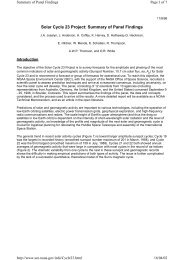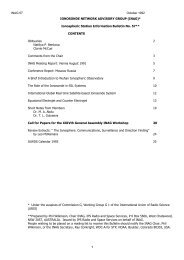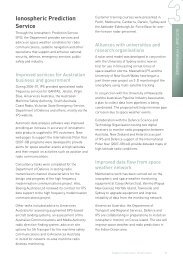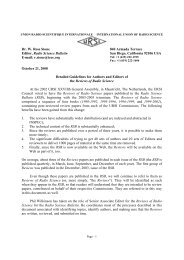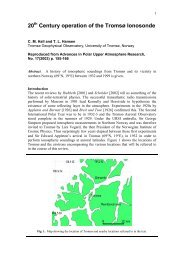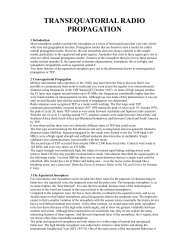UAG-93: Chapters 1 to 5 - URSI
UAG-93: Chapters 1 to 5 - URSI
UAG-93: Chapters 1 to 5 - URSI
You also want an ePaper? Increase the reach of your titles
YUMPU automatically turns print PDFs into web optimized ePapers that Google loves.
5.2 The Standard llodes of Analysis<br />
Ten standard modes of analysis are provided in POLAN. These use values of NT, NV, NR and NH<br />
defined in the data arrays IT, IV, IR and IH. 0ther modes can be used, if desjred, by simply<br />
changing the constants in these arrays. Each array contains 20 values. The first ten are used for<br />
the first real-height expansion, at the beginning of the analysis or after a peak, when no further<br />
real heights are known and NR = 0. At the end of this first step, after NH real heights have been<br />
calculated and the index k advanced by this amount, k is stepped back by a number given in the data<br />
array IR. Thereafter the second ten values in the arrays IT, IV, IR and IH define the values of NT,<br />
NV, NR and NH <strong>to</strong> be used in continuing the analysis. The values of these constants for each mode are<br />
listed in Table 1, with a brief outline of the resu'lting analysis.<br />
Real-height sections determined by the different standard modes of analysis are illustrated in<br />
Fig. l. Vertical lines show the origin of the expansion at the frequency FA. Solid dots represent<br />
known real heights, open circles are calculated real heights, and crosses represent fitted virtual<br />
heights. Mode I corresponds <strong>to</strong> the linear lamjnation analysis, in which a linear section is<br />
caliulated from the last known real height <strong>to</strong> fit the next virtual height. Thus we calculate a<br />
polynomial with NT = I terms, using NR = 0 further real heights and NV = I further vjrtual<br />
heights; the result is used <strong>to</strong> determine NH = 1 further real heights. The new section of the<br />
real-height profile which is determined in this step is shown as a heavy line in Fig. 1.<br />
A negative value of NR is used in some modes. This signals that one of the real heights <strong>to</strong> be<br />
fitted is at the frequency just below FA. This is the case for Mode 3 and Modes 5 <strong>to</strong> 9'in Fig. 1.<br />
An exception is made of Mode 2; <strong>to</strong> give exact agreement with the normal parabolic lamination<br />
analysis, NR = -i here is taken <strong>to</strong> mean that the gradient dhldFN is fitted at the frequency FA.<br />
Mode 2 then calculates a polynomial rvith NT = 2 terms fitting the initial gradient (as determined<br />
from the previous lamination) and the next virtual height.<br />
Mode 4 corresponds <strong>to</strong> the five-term overlapping polynomial analysis described previously<br />
(Titheridge, 1967b). In the present context this reduces <strong>to</strong> MT = 4 terms <strong>to</strong> be determined in the<br />
expansion-(2), since the constant is au<strong>to</strong>matjcally set <strong>to</strong> make the polynomial pass through the point<br />
(FA,HA). The four terms are determined from the next one real-height and three virtual heights.<br />
The polynomial is, therefore, fitted <strong>to</strong> data covering three successive frequency intervals as shown in<br />
Fig. l. The result js used <strong>to</strong> calculate a further section of the real-height curve over the centre<br />
intervai shown by a heavy 1ine. This is somewhat similar <strong>to</strong> a representation by spline functions,<br />
with the polynomial function in each interval matching adiacent functions in both value and gradient<br />
at the end points and in value at one further point each side. In the present implementation,<br />
however, gradient matching is replaced by virtual height matching (which it closely resembles) and<br />
the additional point fitted at the h.igh frequency end is a virtual height and not a real height.<br />
These changes make possible the stepwise solution which can cope with any number of data pojnts.<br />
For each of Modes 1 <strong>to</strong> 4 we have NT = NV + lNRl. Thus the number of terms determined is equal<br />
<strong>to</strong> the number of constraints, and the resulting profile will match the given virtual-height data<br />
exactly (apart from the effect of limited numerical accuracy in the calculations). For each of Modes<br />
5 <strong>to</strong> 10, 1111 11y + lNRl and we get a least-square solution. The calculated polynomials pass<br />
exactly throLrgh the origin (the known point FA,HA), but will not in general give an exact fit t0 the<br />
virtual-height data. A good fit <strong>to</strong> the previously calculated real heights is imposed by giving<br />
greater weight <strong>to</strong> the real-height equations (as discussed in Section 4.3).<br />
Mode 5 gives the procedure currently recommended for most purposes. This uses a polynomial<br />
fitted over two frequency intervals on either side of the real-height section <strong>to</strong> be determined. It<br />
gives appreciably greater accuracy than Mode 4, and slightiy worse in general than Mode 6.<br />
Modes 7 <strong>to</strong> 9 are similar <strong>to</strong> Mode 6, except that each calculated real-height segment covers two<br />
or three data points. Thus the polynomials are obtained from a least-squares fit <strong>to</strong> a larger number<br />
of points, and are used <strong>to</strong> calculate two or three real heights at each step. This gives a faster<br />
analysis with smootheresults. These procedureshould be suitable for analysing data from digital<br />
ionosondes, when large numbers of data points are available. l./ith irregular data it could be<br />
desirable <strong>to</strong> reduce the number of terms in the polynomial; thus an analysis of the type shown for<br />
Mode 9, but with NT reduced <strong>to</strong> about 5, will use three times the normal amount of data and produce<br />
only the normal amount of resolution in the results.<br />
Mode l0 determines a single analytic real-height expression for each 1ayer. It is defined in<br />
PgLAN by NT = 73, NV = 30, NR = 0 and NH = 30. This permits up <strong>to</strong> 30 virtual-height data points<br />
<strong>to</strong> be included in the analysis. The limit is set by the dimensions of the array B(32,17) in P0LAN,<br />
and can be changed <strong>to</strong> enable any number NMAX of virtual heights <strong>to</strong> be used by altering the first<br />
dimension <strong>to</strong> NMX+2. Values of NT > 20 are interpreted in P0LAN as giving a percentage of (NV+2);<br />
thus Mode l0 as currently defined uses NT = 0.73(NV+2) terms in the analytic real height expressjon.<br />
This always gives a least-square solution, including all the ordinary and extraordinary ray data for<br />
a given 1ayer.<br />
1j




